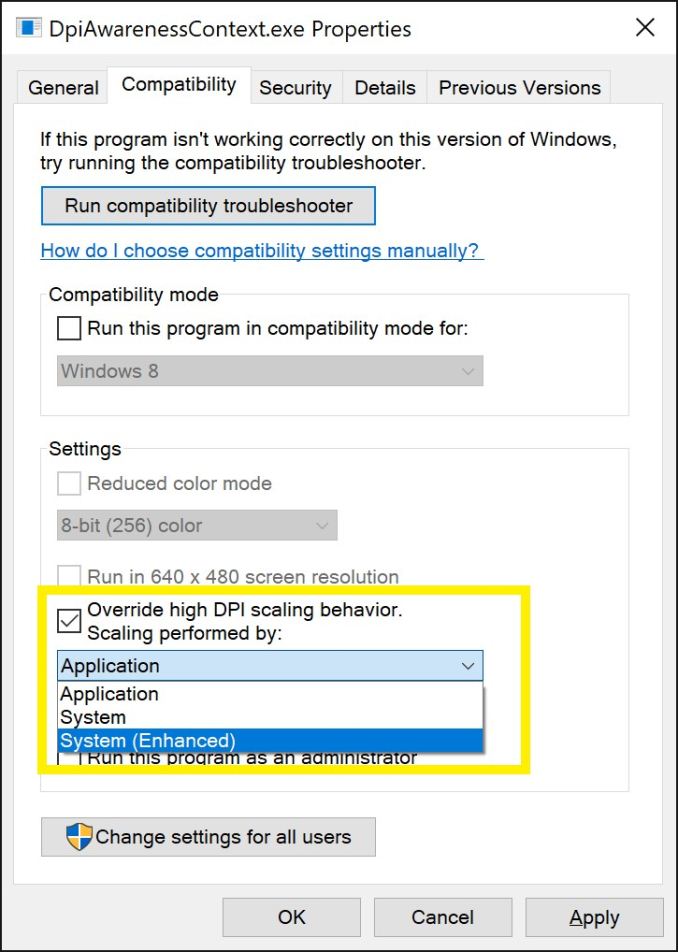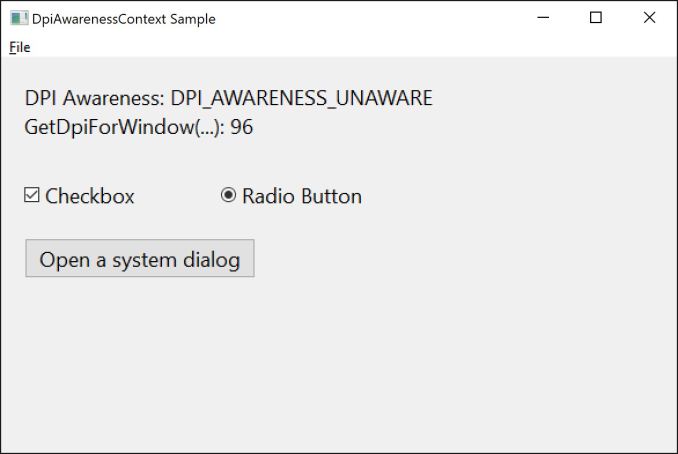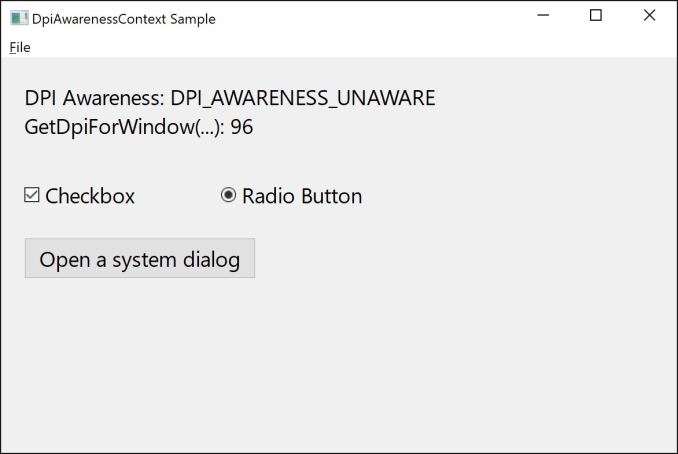The Windows 10 Creators Update Arrives
by Brett Howse on April 25, 2017 8:00 AM EST- Posted in
- Software
- Operating Systems
- Windows
- Microsoft
- Windows 10
High DPI Changes
Although the Mac had a fairly seamless transition to “Retina” displays, Microsoft hasn’t had the luxury of owning the end-to-end product, and as always with Windows, there is a huge backlog of older applications as well. To say the transition to high DPI has been a challenge would be an understatement. They have made some great progress here, but they still have a lot of work to do, and they don’t have the developer buy-in to just add ways for developers to fix their apps either. Any changes here need to benefit the myriad of applications that don’t, and likely never will, support high DPI APIs.
UWP apps are practically exempt from these issues, but the majority of Windows applications are not UWP, and even tools Microsoft has built to help developers bring their apps to the store, such as the Centennial bridge to convert Win32 apps to packaged apps for the store, can’t fix the underlying issues with supporting applications that were built for 96 DPI on displays with double, triple, or even more, DPI.
But that hasn’t stopped Microsoft from making progress. The Anniversary Update brought some nice changes and worked on per-monitor DPI awareness issues, and introduced mixed-mode DPI scaling, and DPI awareness at the process level instead of just the application level.
A graphic showing many of the common issues with High DPI, especially on mulitple different DPI displays
With the Creators Update, they are introducing a new way to handle per-monitor DPI issues, which they have dubbed Per-monitor DPI awareness V2. The new method adds support for child window DPI change notifications, automatically enabled non-client scaling, automatic DPI scaling for dialog boxes, and more control for dialog scaling. All of these are to improve how a developer handles DPI scaling, and especially on a system with multiple monitors with different DPIs, which has been one of the biggest sore spots even as the primary monitor DPI issues have been worked on over the last couple of years. This is an incredibly common scenario too, with a high-resolution laptop docked to a standard resolution display, for example.
Win32 clearly has a lot of baggage to deal with, but hopefully we will continue to see API improvements in Windows 10 updates to keep chipping away at these issues. However, this assumes that a developer is actually going to update their application. That may never happen.
When looking at this issue three years ago when we looked at DPI issues in Windows, one of the conclusions was that Windows has to stop expecting applications to behave correctly. There needed to be an override on the exe to force it to be scaled by Windows, since many applications were claiming to be DPI aware, when they were not at all. If the application could be set to ignore this flag, at least Windows would be able to scale it using bitmap stretching. It wouldn’t be ideal, but it could perhaps make the application useable when it would otherwise not be.
Microsoft has somewhat addressed this, with a new setting in the application compatibility called System (enhanced) DPI scaling. This new setting has some limitations, but is effective enough that Microsoft is using it for some built-in applications. Functionality is limited to GDI-based applications and it won’t correctly scale GDI+ content, DX content, or bitmap content, so it may have limited appeal. End users will have to try this on any application they are having DPI issues with to see if it helps.
But when it does help, it helps a lot. Microsoft is using this new scaling method to fix the Microsoft Management Console (mmc.exe) which means the device manager, and more, will be scaled correctly in the Creators Update. Here’s a screenshot of the differences.
Enhanced Scaling OFF
Enhanced Scaling ON
If the application is mostly text based, it could be improved quite a bit with the new mode. It’s not going to solve all applications from having issues, but it’s a nice step in the right direction.
They have also fixed desktop icons being scaled incorrectly if running in a mixed monitor environment.
Microsoft acknowledges there is still work to be done here, especially in the mixed monitor scenario. They are looking at having the Display Settings section show displays in their physical size rather than resolution, which would help a lot if you have a low-resolution monitor that’s larger than a high-resolution monitor, and it makes dragging windows between them difficult. They would also like to address the weird giant windows you get dragging windows from a high DPI display to a low DPI display. There is more coming as well, so stay tuned.














69 Comments
View All Comments
leexgx - Wednesday, April 26, 2017 - link
""Consumers want more features, and sooner, but business needs to test everything before rolling it out.""interesting most people don't give a damn what new version of windows 10 offers, all they are interested in is that what ever browser works so they can do email and other stuff
for most a feature upgrade, this list is a follows
1 application PC settings are reset (browser and associations like PDF and pictures)
2 it uninstalls software without permission that was perfectly working fine (and still works perfectly fine when you reinstall it)
3 can't use there PC for about 2-8 hours when it does the upgrade (slow CPU/RAM/HDD vs SSD)
4 or better a non booting PC (or black screen as some may encounter as they broke the Video WDDM for some old video drivers and it sets the output to 0x0 resolution)
the Fix is use LTSB version if MS wount offer a legitimate LTSB single user licence then how are people supposed to buy it
jabber - Tuesday, April 25, 2017 - link
Just be aware that if you have a mix of Office products say 2010 and 13/16 it will still delete off the latest versions if you do an upgrade. Well done MS, still not fixed that one.Gich - Tuesday, April 25, 2017 - link
it didn't happen to me...I got Office 2007 and 16.
jabber - Tuesday, April 25, 2017 - link
The disappointment for me is that MS is concentrating on adding fluff, bling and bloat I have zero use for but not concentrating on making it more secure, robust and faster. I'd also like a return of the custom install option so I can choose to install that fluff or not.Dave Null - Tuesday, April 25, 2017 - link
Indeed. I finally bit the bullet and installed the LTSB version. This is the lightweight version of Windows I've been looking for.lord_anselhelm - Tuesday, April 25, 2017 - link
Agreed. I also wish they'd focus on fixing bugs they've introduced as a result of updates. For example, Anniversary Update broke centre-alignment of folder/filenames in certain folder views and caused Libraries to start ignoring custom folder views. Both issues still exist in the Creators Update!Gasaraki88 - Tuesday, April 25, 2017 - link
"secure, robust and faster"What does that even mean? How do you even quantify that enough to be worth an update. Do you want them to list that inthe change logs?
herbc - Wednesday, April 26, 2017 - link
Yup , a grossly overbloated OS from the start continues to get worse , my God the idiocy of MS is mind boggling.MutualCore - Sunday, April 30, 2017 - link
Your comment has no substance.fm13 - Tuesday, April 25, 2017 - link
I still can't install this thing - Windows Update seems busted and standalone installer stays stuck on 99% for days.Although Win10 is a nice OS, some things in it seem broken - things that worked flawlessly for years. For example, virus definitions on my system can't update themselves anymore - I have to download and install them manually.
How the hell do you break something like that?